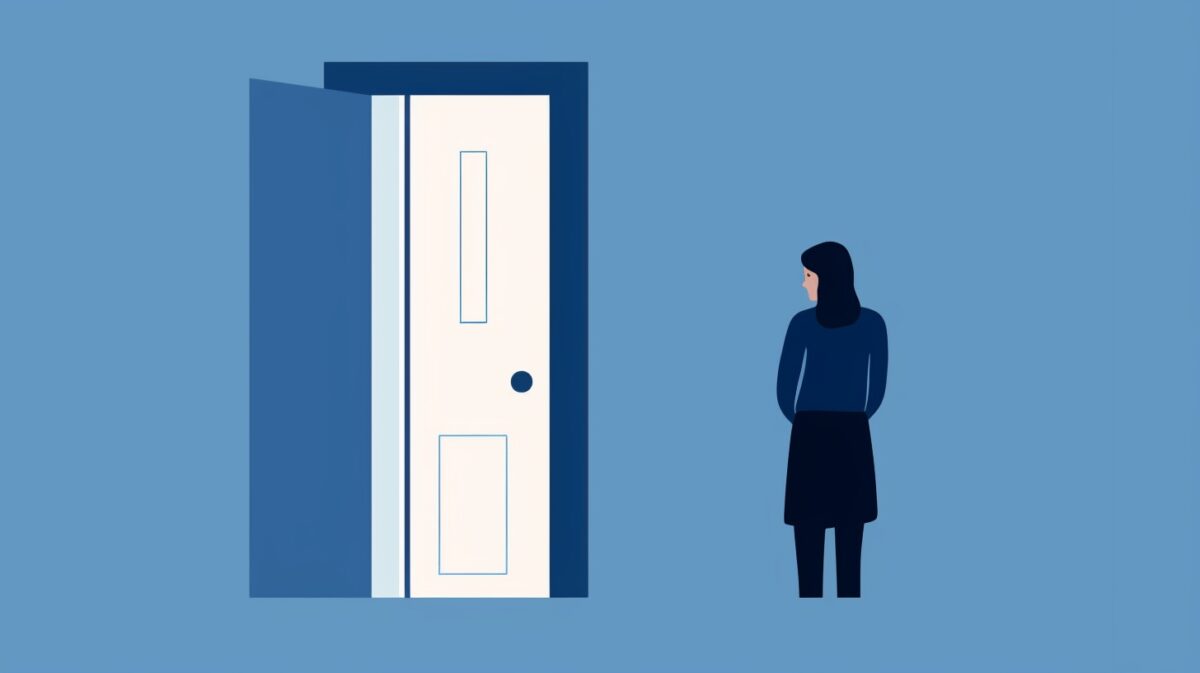Hey there! Have you ever found yourself in a constant cycle of negative self-talk? You know, those relentless thoughts that chip away at your confidence and self-esteem? Well, you’re not alone. Many of us battle with negative self-talk from time to time, and it can have a significant impact on our mental health and well-being.
But here’s the good news: you have the power to break free from this damaging habit and empower yourself to cultivate a more positive mindset. In this article, we’ll explore various tools and techniques that can help you overcome negative self-talk and bring about a shift towards self-compassion and self-belief.
Negative self-talk can manifest in different ways, such as self-doubt, self-criticism, or even harsh judgments about ourselves. This inner dialogue can be influenced by various factors, including past experiences, societal comparisons, and unrealistic expectations. However, it’s important to remember that negative self-talk is not a reflection of your true worth or capabilities.
By understanding the impact of negative self-talk and recognizing its patterns, you can begin to challenge and replace these negative thoughts with positive affirmations. Cultivating mindfulness can also be a powerful tool in combatting negative self-talk, while seeking support from loved ones or professionals can provide additional guidance on your journey towards self-empowerment.
So, if you’re ready to take control of your inner narrative and free yourself from the clutches of negative self-talk, let’s dive deeper into the tools and techniques that can help you along the way. You deserve to live a life filled with self-compassion, self-belief, and positive growth. Let’s get started!
Understanding Negative Self-Talk
Negative self-talk is a common phenomenon that affects many people. It refers to the inner dialogue or thoughts that are self-critical, self-blaming, and self-defeating. These negative thoughts can have a significant impact on our mental health and overall well-being. Let’s dive deeper into understanding negative self-talk and its effects:
Definition and Examples
Negative self-talk can manifest in various ways, and it often involves the repetitive patterns of critical thoughts that we have about ourselves. Here are some examples of negative self-talk:
- Catastrophizing: Magnifying small setbacks and turning them into major disasters. For example, thinking, “I made a mistake in my presentation; I’m such a failure. I’ll never succeed at anything.”
- Personalizing: Taking responsibility for things that are beyond our control. For example, thinking, “My friend canceled plans with me; it must be because they don’t like me anymore.”
- Black-and-White Thinking: Seeing things only in extremes without considering shades of gray. For example, thinking, “I didn’t get the job; I’m completely unemployable.”
- Overgeneralization: Making broad assumptions based on a single negative experience. For example, thinking, “I failed one math test; I’m terrible at math and will always be.”
Effects on Mental Health and Well-being
Negative self-talk can have detrimental effects on our mental health and overall well-being. Here are some ways it can impact us:
- Low self-esteem: Constantly bombarding ourselves with negative thoughts can erode our self-confidence and self-worth.
- Increased anxiety: Negative self-talk often leads to increased feelings of worry, stress, and anxiety.
- Depression: Persistent negative thoughts can contribute to feelings of sadness, hopelessness, and depression.
- Limited potential: Believing negative self-talk can limit our ability to take risks and reach our full potential.
- Impaired relationships: Negative self-talk can affect how we perceive ourselves and others, leading to strained relationships.
Understanding the impact of negative self-talk is the first step to overcoming it. By recognizing the patterns and effects, we can take proactive steps to challenge and replace negative thoughts with more positive and constructive ones.
Identifying Patterns of Negative Self-Talk
Negative self-talk can be insidious and ingrained in our thought patterns. Often, we may not even realize when it is happening. Taking the time to identify and recognize these patterns is a crucial step towards empowering yourself to overcome them. Here are some key techniques for identifying patterns of negative self-talk:
Recognizing Common Negative Self-Talk Patterns
- Labeling: This pattern involves using derogatory labels or names to describe yourself, such as “I’m a failure” or “I’m stupid.”
- Catastrophizing: This pattern involves always assuming the worst-case scenario in a given situation. You may find yourself thinking, “Everything is going to go wrong,” or “This is a disaster waiting to happen.”
- Mind-reading: This pattern involves assuming what others are thinking without any evidence. For example, you might think, “They must think I’m boring,” or “Nobody likes me.”
- Personalization: This pattern involves taking blame for things that are beyond your control. You might say to yourself, “It’s all my fault,” or “I always mess everything up.”
By becoming aware of these common negative self-talk patterns, you can start to catch yourself when engaging in them. This self-awareness is the first step in challenging and changing those thoughts.
Exploring Personal Triggers
Identifying your personal triggers for negative self-talk is another important aspect of overcoming it. Triggers can vary from person to person, but here are some common triggers to consider:
- Comparisons: Constantly comparing yourself to others can lead to feelings of inadequacy and negative self-talk.
- Mistakes: Making a mistake or experiencing failure can trigger negative self-talk and feelings of self-doubt.
- Criticism: Receiving criticism, whether constructive or not, can often lead to negative self-talk.
- Stress and Pressure: Times of high stress or pressure can amplify negative self-talk, as you may put unnecessary expectations on yourself.
Take some time to reflect on situations or circumstances that tend to trigger negative self-talk for you. By being aware of these triggers, you can take steps to mitigate their impact and develop healthier coping mechanisms.
Remember, identifying patterns of negative self-talk is a journey, and it takes practice and patience. Be gentle with yourself as you navigate this process and celebrate each small victory along the way.
Challenging Negative Self-Talk
Negative self-talk can be incredibly damaging to our mental health and well-being. It erodes our self-esteem, saps our confidence, and holds us back from reaching our full potential. Fortunately, there are powerful techniques that can help us challenge and overcome negative self-talk. Let’s take a look at some effective strategies:
Questioning the Validity of Negative Thoughts
One of the first steps in challenging negative self-talk is to question the validity of our negative thoughts. Just because we think something doesn’t make it true. By examining and challenging the accuracy of our negative thoughts, we can start to unravel the negative self-talk cycle. Here’s how we can do it:
- Identify the negative thought: Start by becoming aware of the negative thought that is running through your mind. What is the exact thought or belief that is causing you distress?
- Question the evidence: Ask yourself, “Is there any evidence to support this negative thought?” Are there any facts or objective information that back up this belief? Often, we’ll find that the evidence is scarce or non-existent.
- Consider alternative perspectives: Challenge your negative thought by considering alternative perspectives. How would a close friend or family member respond to this thought? What would they say to counter it?
- Replace negative thoughts with positive ones: Once you’ve questioned the validity of your negative thought, replace it with a positive and empowering thought. For example, if your negative thought is “I’ll never succeed,” replace it with “I am capable of achieving my goals with perseverance and hard work.”
Examining Evidence to Challenge Negative Beliefs
Another powerful way to challenge negative self-talk is by examining the evidence that supports or contradicts our negative beliefs. Often, we hold onto negative beliefs about ourselves without truly examining whether they are true or not. Here’s how we can challenge our negative beliefs:
- Write down your negative belief: Take a moment to write down the negative belief that you have about yourself. It could be something like “I’m a failure” or “I’m not good enough.”
- List supporting evidence: Next, list any evidence that supports this negative belief. Be as objective as possible and consider whether this evidence is valid or if it’s simply your own biased perception.
- List contradicting evidence: Now, list any evidence that contradicts your negative belief. Think about past experiences, achievements, and positive feedback that you have received. This will help you see that your negative belief isn’t entirely accurate.
- Reframe your belief: Finally, reframe your negative belief into a more realistic and positive belief. For example, if your negative belief is “I’m a failure,” reframe it as “I have faced challenges in the past, but I have also overcome them and learned valuable lessons along the way.”
By challenging our negative thoughts and beliefs, we can begin to break free from the grip of negative self-talk and create a more positive and empowering inner dialogue. Remember, it takes time and practice to change our thought patterns, so be patient with yourself during this process.
Replacing Negative Self-Talk with Positive Affirmations
Negative self-talk can have a significant impact on our mental health and overall well-being. It can hold us back from reaching our full potential and hinder our ability to lead a fulfilling life. One effective way to counteract negative self-talk is by replacing it with positive affirmations. Affirmations are powerful statements that help reframe our thoughts and beliefs, enabling us to overcome self-doubt and cultivate a more positive mindset.
Creating Personalized Positive Affirmations
To begin replacing negative self-talk with positive affirmations, it’s important to create personalized statements that resonate with you. Consider the following steps:
- Identify Your Negative Self-Talk: Pay attention to the negative thoughts and beliefs that frequently arise within you. Recognize the patterns of negative self-talk that tend to hold you back.
- Challenge Your Negative Beliefs: Take a moment to challenge the validity of your negative thoughts. Are they based on facts or are they distorted perceptions? Questioning your beliefs can help you see them in a more objective light.
- Write Down Positive Counter Statements: Once you’ve identified your negative self-talk, write down positive statements that counteract those negative beliefs. For example, if you often think, “I’m not competent enough,” replace it with, “I am capable and skilled in what I do.”
- Make Your Affirmations Specific and Realistic: Ensure that your affirmations are specific, realistic, and relevant to your goals. Instead of using generic statements like “I am awesome,” be more specific and say something like, “I am confident in my abilities to tackle challenges.”
Implementing Affirmations in Daily Life
Creating positive affirmations is just the first step. The key is to incorporate them into your daily routine and consistently reinforce them. Here are some techniques to help you do just that:
- Repeat Affirmations Daily: Set aside a few minutes each day, preferably in the morning or before bedtime, to repeat your affirmations aloud. The repetition helps reinforce positive beliefs in your subconscious mind.
- Utilize Visual Aids: Create visual aids such as affirmation cards or posters that you can place in prominent places like your bathroom mirror, office desk, or refrigerator. Seeing them regularly serves as a reminder to replace negative thoughts with positive affirmations.
- Use Affirmation Apps or Recordings: There are numerous smartphone apps and recordings available that provide a daily dose of positive affirmations. These resources can help you stay consistent and motivated in your practice.
- Practice Gratitude: Incorporate gratitude into your daily routine by expressing thanks for the positive aspects of your life. Gratitude can help reinforce a positive mindset and make it easier to replace negative self-talk with affirmations.
Remember, replacing negative self-talk with positive affirmations is a process that takes time and practice. Be patient with yourself and celebrate small victories along the way. With consistent effort, you can gradually shift your mindset and cultivate a more positive, empowering inner dialogue that will support your personal growth and well-being.
“Affirmations are like planting seeds in the ground. You sow them in your mind, and they grow and blossom into beautiful experiences in your life.” – Louise Hay
Cultivating Mindfulness to Combat Negative Self-Talk
In our previous sections, we discussed various techniques for identifying and challenging negative self-talk patterns. Another powerful tool that can help you overcome negative self-talk is mindfulness. Mindfulness is the practice of purposefully paying attention to the present moment without judgment. It involves tuning into your thoughts, emotions, and sensations in a non-reactive way. By cultivating mindfulness, you can become more aware of your negative self-talk and learn to respond to it more effectively. Here are some strategies to help you incorporate mindfulness into your life:
Practicing Mindfulness Meditation
- Find a quiet and comfortable space where you can sit or lie down.
- Close your eyes and take a few deep breaths to settle your mind and body.
- Shift your attention to your breath, noticing the sensation of each inhale and exhale.
- As thoughts or emotions arise, acknowledge them without judgment and gently guide your attention back to your breath.
- Start with short sessions, such as 5 minutes, and gradually increase the duration as you become more comfortable.
Benefits of Mindfulness
- Reduces stress and anxiety.
- Increases self-awareness and acceptance.
- Enhances focus and concentration.
- Improves emotional regulation.
- Promotes overall well-being.
Developing Awareness of Thoughts and Emotions
- Throughout the day, take a few moments to check in with yourself and observe your thoughts and emotions.
- Notice any negative self-talk that arises and simply observe it without getting entangled in the content.
- Pay attention to the physical sensations associated with negative thoughts and emotions, such as tension in your body or a racing heart.
- Remind yourself that thoughts and emotions are transient experiences that do not define you.
- Practice self-compassion by offering yourself kind and supportive thoughts, recognizing that everyone experiences negative self-talk at times.
By incorporating mindfulness into your daily life, you can become more attuned to your negative self-talk and choose how to respond to it. Remember, the goal is not to eliminate negative thoughts but to develop a healthier relationship with them. With practice, you can cultivate a sense of inner calm and resilience, allowing you to navigate life’s challenges with greater ease.
“Mindfulness is simply being aware of what is happening right now without wishing it were different; enjoying the pleasant without holding on when it changes (which it will); being with the unpleasant without fearing it will always be this way (which it won’t).” – James Baraz
Seeking Support and Professional Help
Sometimes, overcoming negative self-talk can be a challenging journey. It’s important to remember that you don’t have to go through it alone. Seeking support from others can make a significant difference in your ability to overcome negative self-talk and develop a healthier mindset. Here are some ways you can seek support and professional help:
1. Building a Supportive Network
Surrounding yourself with a supportive network of friends, family, and loved ones can provide you with the emotional support and encouragement that you need. These individuals can offer a listening ear, share their own experiences, and provide a fresh perspective on your negative self-talk. Here are some ways to build a supportive network:
- Reach out to trusted friends or family members who you feel comfortable confiding in.
- Join support groups or online communities where you can connect with others who are going through similar struggles.
- Seek out positive and uplifting social circles that will uplift and motivate you.
2. Benefits of Therapy and Counseling
Sometimes, seeking professional help from a therapist or counselor can be extremely beneficial in addressing negative self-talk. These professionals have the knowledge and expertise to guide you through the process of overcoming negative thought patterns. Here are some benefits of therapy and counseling:
- Therapists can help you identify the underlying causes of your negative self-talk and provide tools and strategies to challenge and change these thoughts.
- They can teach you techniques such as cognitive-behavioral therapy (CBT) to reframe and restructure negative thinking patterns.
- Therapists can help you develop skills to manage stress, anxiety, and other mental health issues that may contribute to negative self-talk.
- They provide a safe and non-judgmental space for you to explore and express your thoughts and emotions.
Remember, seeking support and professional help is a sign of strength, not weakness. It takes courage to acknowledge that you need assistance and reach out for it. So, don’t hesitate to seek the help you need to overcome negative self-talk and improve your mental well-being.
Improving Self-Esteem and Self-Confidence
When we engage in negative self-talk, our self-esteem and self-confidence can take a major hit. The good news is that there are many techniques and tools we can use to empower ourselves and build a healthier relationship with ourselves. Here are some strategies to help improve self-esteem and self-confidence:
Celebrating Achievements and Self-Appreciation
-
Acknowledge your accomplishments: Take the time to recognize and celebrate your achievements, no matter how big or small they may seem. It could be completing a project at work, reaching a personal goal, or even just getting through a challenging day. Celebrating these moments can help boost your self-esteem and remind you of your capabilities.
-
Practice self-appreciation: Make a list of your positive qualities or things that you appreciate about yourself. This can be anything from your sense of humor to your ability to persevere. Whenever you’re feeling down or doubting yourself, revisit this list and remind yourself of your worth.
Setting Realistic Goals
-
Break it down: Setting small, achievable goals can help build confidence and self-belief. Break bigger tasks into smaller steps, and celebrate each milestone you accomplish along the way. This way, you’ll build momentum and see tangible progress, which can help boost your self-confidence.
-
Focus on personal growth: Instead of comparing yourself to others, set goals that are aligned with your personal growth. Everyone’s journey is unique, and focusing on your own progress rather than external standards will help you appreciate your own accomplishments and boost your self-esteem.
Remember, improving self-esteem and self-confidence is a journey, and it takes time and practice. Be patient with yourself, and remind yourself that you are worthy of love and self-acceptance.
Creating a Positive Environment
Creating a positive environment is crucial when it comes to overcoming negative self-talk. Surrounding yourself with positive influences and eliminating negative triggers can greatly impact your mental well-being. Here are some strategies to help you create a positive environment:
Surrounding Yourself with Positive Influences
- Choose Positive Company: Spend time with people who uplift and inspire you. Surrounding yourself with positive-minded individuals can have a significant impact on your thoughts and beliefs.
- Engage in Positive Activities: Engaging in activities that bring you joy and happiness can help shift your focus away from negative self-talk. Whether it’s pursuing a hobby, practicing self-care, or spending time in nature, make time for activities that nourish your soul.
- Seek Inspiration from Role Models: Identify role models who have overcome similar challenges and draw inspiration from their stories. Learning about their journeys can motivate you to silence your own negative self-talk.
Eliminating Negative Triggers
- Identify Negative Influences: Take inventory of the people, places, or situations that trigger negative self-talk. It could be certain people’s criticism, social media comparison, or toxic environments. Recognizing these triggers is the first step towards eliminating them.
- Set Boundaries: Establishing boundaries with people who consistently bring negativity into your life is essential. Learn to say no to engagements or situations that drain your positivity.
- Monitor Media Consumption: Be mindful of the media you consume. Limit exposure to negative news or social media platforms that perpetuate comparison or unhealthy standards. Instead, focus on uplifting and educational content.
Remember, creating a positive environment takes time and effort. It may require making changes to your social circle, habits, or media consumption. Be patient with yourself and celebrate small victories along the way. Over time, you’ll notice that your positive environment contributes to reducing negative self-talk and improving your overall well-being.
“Surround yourself with positive people who believe in your dreams, encourage your ideas, support your ambitions, and bring out the best in you.” – Roy T. Bennett
Conclusion
In conclusion, negative self-talk can have a profound impact on our mental health and well-being. However, by understanding the nature of negative self-talk and implementing effective strategies, we can empower ourselves to overcome it and cultivate a more positive inner monologue. Here are some key takeaways:
- Recognize negative self-talk patterns: Be aware of the common patterns and triggers that lead to negative self-talk. By identifying these patterns, you can better understand and challenge them.
- Challenge the validity of negative thoughts: Question the accuracy and truth of your negative thoughts. Often, we tend to exaggerate or distort reality, leading to negative self-talk. Take a step back and objectively examine the evidence for and against these thoughts.
- Replace negative self-talk with positive affirmations: Create personalized positive affirmations that counteract your negative self-talk. Repeat these affirmations regularly to rewire your brain and shift your mindset towards positivity.
- Cultivate mindfulness to combat negative self-talk: Practice mindfulness meditation to develop awareness of your thoughts and emotions. By observing your thoughts without judgment, you can detach from negative self-talk and cultivate a more balanced and positive perspective.
- Seek support and professional help: Building a supportive network of friends and loved ones can provide valuable emotional support and perspective. Additionally, consider the benefits of therapy and counseling in addressing deeper-rooted issues contributing to negative self-talk.
- Improve self-esteem and self-confidence: Celebrate your achievements and engage in self-appreciation to boost your self-esteem. Set realistic goals and celebrate small steps towards progress to build self-confidence and counteract negative self-talk.
- Create a positive environment: Surround yourself with positive influences and eliminate negative triggers. Surrounding yourself with positivity can have a profound impact on your inner monologue and overall well-being.
Remember, overcoming negative self-talk is a journey that requires patience and self-compassion. With consistent effort and the right tools, you can empower yourself to cultivate a more positive and empowering inner monologue, leading to improved mental wellness.
And if you’d like to explore tools and techniques that can help you on your journey, be sure to check out ocd.app. With their innovative approach to improving inner monologue, they are dedicated to enhancing people’s wellness and fostering positive self-talk. Find out more at ocd.app.
Frequently Asked Questions
- What is negative self-talk?
Negative self-talk refers to the inner dialogue or thoughts that are self-critical, self-defeating, and pessimistic. It involves the habit of constantly putting oneself down and focusing on negative aspects of oneself or situations.
- Why is negative self-talk harmful?
Negative self-talk can be harmful as it affects self-esteem, confidence, and mental well-being. It reinforces negative beliefs about oneself and can lead to feelings of depression, anxiety, and self-doubt.
- What are some common examples of negative self-talk?
Common examples of negative self-talk include: ‘I’m not good enough’, ‘I always mess things up’, ‘I will never succeed’, ‘Nobody likes me’, ‘I’m a failure’, and ‘I’m so stupid’.
- How can I overcome negative self-talk?
To overcome negative self-talk, you can practice mindfulness, challenge negative thoughts by questioning their validity, replace negative thoughts with positive affirmations, surround yourself with positive influences, seek therapy or counseling, and engage in self-care activities.
- Are there any tools or techniques to help overcome negative self-talk?
Yes, there are several tools and techniques to overcome negative self-talk. These include cognitive-behavioral therapy (CBT), journaling, meditation, visualization, positive self-talk exercises, and seeking support from friends, family, or professionals.
| | |
| | |
| | |
| | |
| | 91% see first results within a week |
| | |
| | 4.8 / 5.0 (2,635 reviews) |











